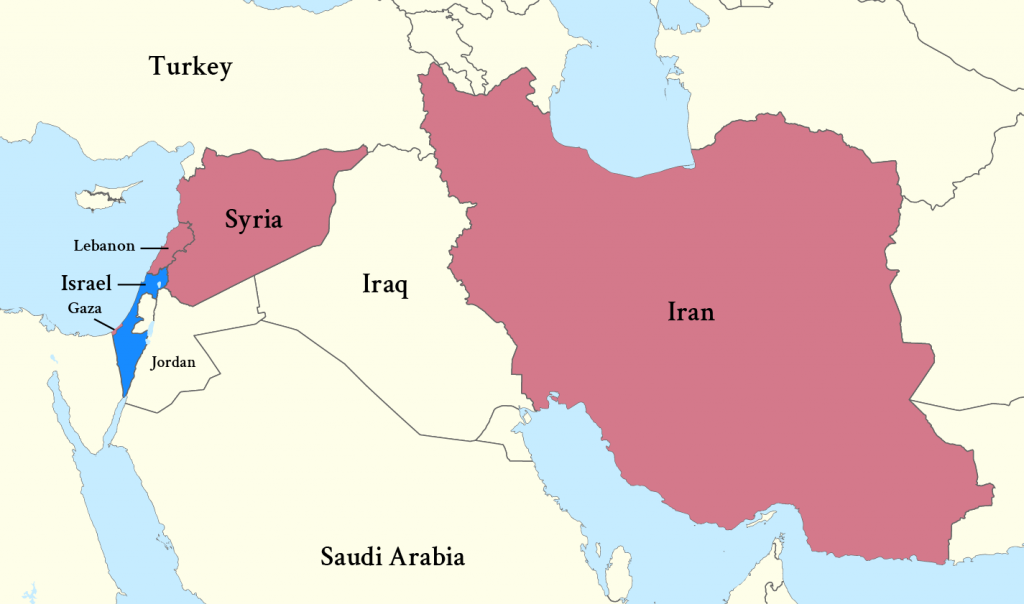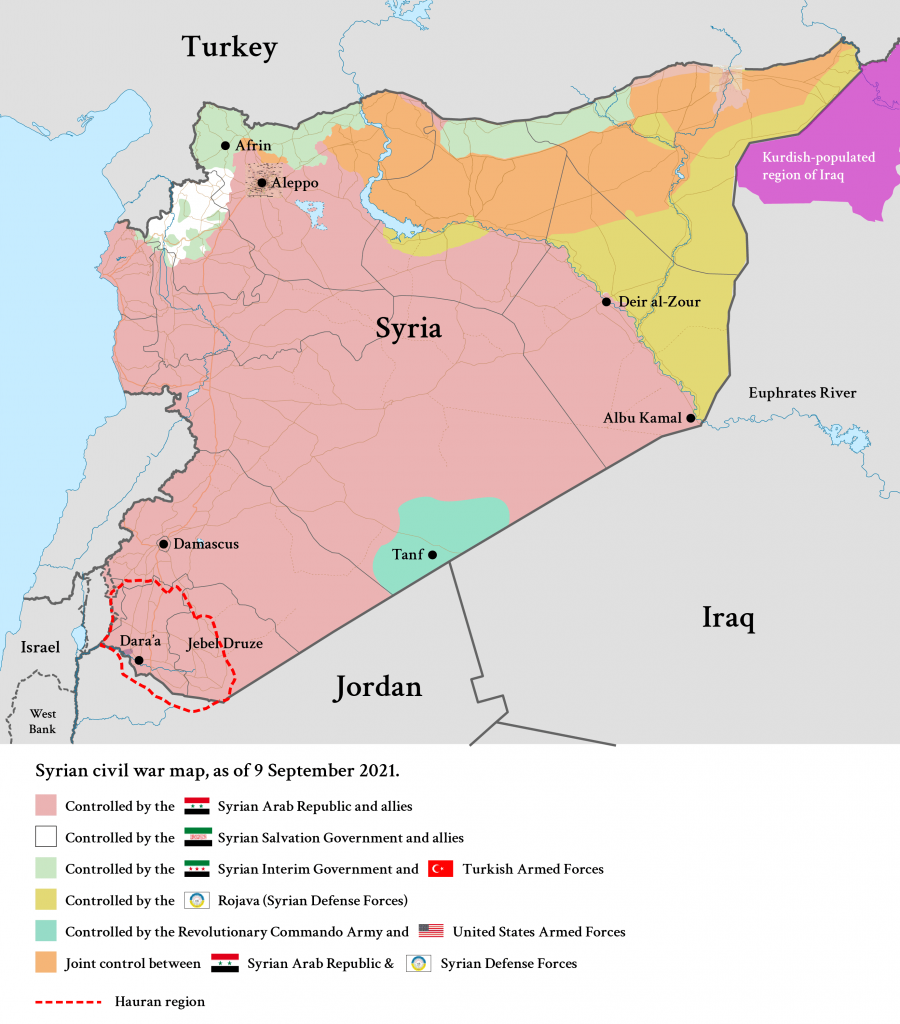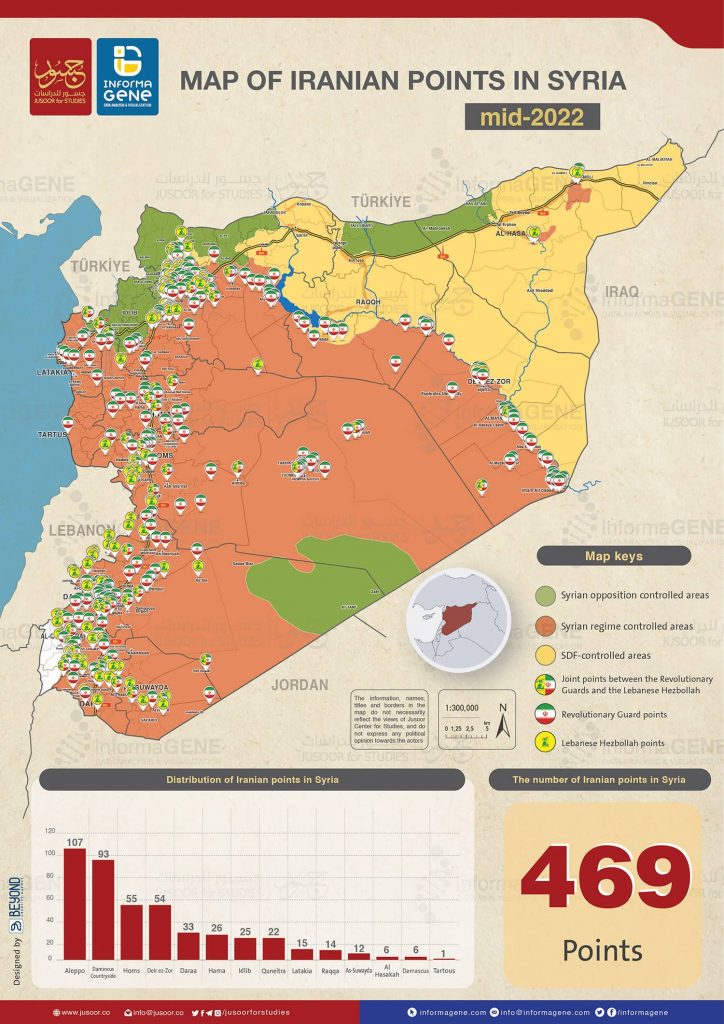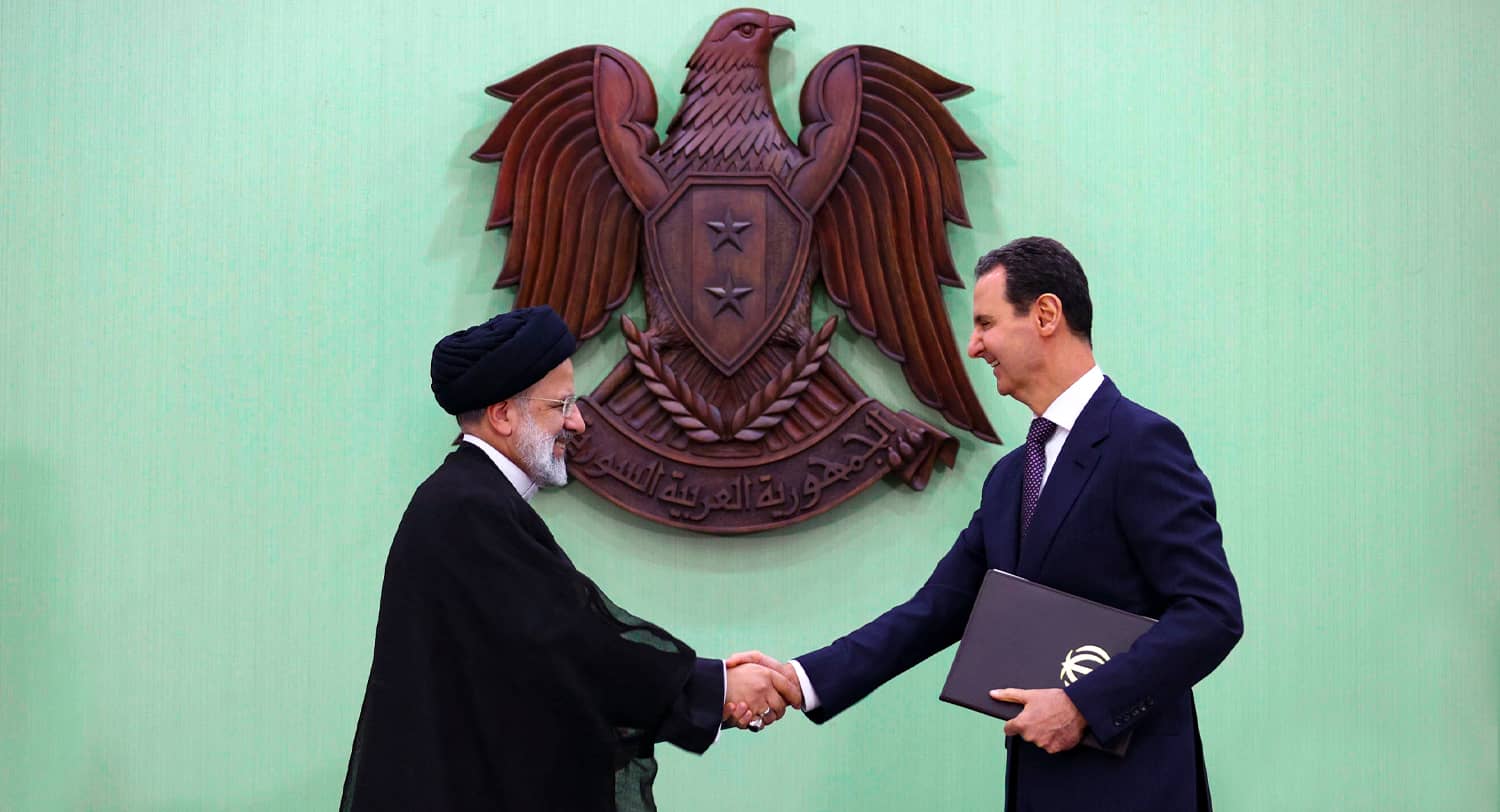Apart from the Syrian people themselves, Israel comes out of the 12 years of civil war in Syria as the biggest loser. The survival of the Assad regime, closely allied with Iran, amounts to nothing short of an Israeli strategic failure.
Assad’s survival turns Iran into Israel’s next-door neighbor, exercising growing influence on the rebuilding of Syria’s armed forces. It allows for land corridors through Iraq and (via direct flights from Iran) an air bridge that equip Lebanese Hizbullah’s heavy missiles with precision guidance kits, making them far more accurate. It enables Shi’ite militias sponsored by the Iranian Revolutionary Guard Corps to mount large-scale campaigns to smuggle weapons (and drugs) into Jordan intended to supply Palestinian groups in the West Bank.
In brief, the threat to Israel is increasing and the military challenges faced by the Israel Defense Forces are becoming more complex.
Syria is rarely part of the political debate in Israel nor did it receive much attention during the five parliamentary elections over the past four years. Israel’s security and intelligence establishments believe that the hundreds of air raids against the IRGC in Syria since 2016 have succeeded in foiling the Iranian plan to establish offensive capabilities on Syrian territory. A former Israeli prime minister went so far as to express in private his “hope” that Teheran would send more military into Syria where the IDF enjoys both air and intelligence superiority, thus enabling the IDF to inflict more pain on them.
Israel’s short-term tactical calculations ignore the longer-term risks. Iran is determined to accept substantial losses in order to persist in its primary objective: deploying long and medium-range missiles in Syria, complete with air defense systems. So far, Iran has shied away from sending significant numbers of its own troops to Syria, preferring instead to send teams of IRGC ”advisors” to command mostly Shiite militiamen and local recruits. In the future, under a new Supreme Leader and following modernization of its air force, Teheran may be prepared to raise the stakes.
Qassem Suleimani’s Strategic Plan
Obtaining missile bases in Syria would signal a dramatic progress in Iran’s plan to encircle Israel with a ring of missile arsenals, stretching from the Mediterranean to the Yarmouk River in the north and east, in addition to the Gaza Strip in the southwest. IRGC operatives are also trying to help Hamas and Palestinian Islamic Jihad organize their followers in the West Bank to begin assembling home-made improvised rockets targeting Israeli main population centers.
The late commander of al-Qods Corps of the IRGC, General Qassem Suleimani, conceived a plan to set up an Iranian-sponsored war machine on Syria’s territory including thousands of missile pads, fleets of UAVs, anti-aircraft batteries and a chain of fortified positions along the Israeli border backed by a variety of intelligence-gathering installations. He was the first Middle Eastern leader with a detailed strategy of gradually strangling Israel. He did not follow President Nasser’s plan of a collective offensive of Arab armies to crush Israel. Rather he would deploy irregular forces, an array of strong militias equipped with enormous quantities of rockets and missiles and guided by Iran to pose an existential threat to Israel. His plan was slow attrition not a surprise attack.

Israel’s Initial Response to the Syrian Civil War
After the outbreak of the uprising against Assad in March 2011, Israel chose a policy of non-interference and refrained from taking significant covert actions to help the rebels topple his regime.
There were two main reasons for this decision. First, Israel wanted to avoid chaos and wanted a government to its north that would continue the ceasefire established in 1974. Second, Israel had a grave concern that jihadist militias – including Islamic State and al-Qaeda disciples – may overcome the secular and more moderate factions in the struggle to replace Assad. Some Syrian army’s forward outposts close to the Israeli border in the Golan were overrun by the Jabhat al-Nusra affiliate of al-Qaeda and later by Islamic State supporters.
Israel was also watching how its US ally was responding to the Syrian civil war. The US was mainly interested in preventing a clear-cut victory by Assad, his Russian patrons and Iranian partners, via a policy aimed at “freezing” a situation in which Assad controls less than 70% of Syria’s territory. This goal was achieved by helping the Kurds maintain an autonomous entity east of the Euphrates River, establishing a US -managed enclave around Tanf in the south and tacitly supporting Turkey’s capture of three regions in the north and Turkey’s deterrence of a Syrian assault on the rebel-held province of Idlib.
The implications of Assad’s survival on Iran’s long-term plans vis-à-vis Israel were not fully grasped by Israeli intelligence. In 2018, for example, Jerusalem was happy to accept President Putin’s “guarantee” that his (mostly Russian Muslim) military police battalions would make sure IRGC elements did not deploy closer than 70-80 kilometers from the Golan border. The IDF was also late in realizing that the Iraqi Shi’ite militia (called Popular Mobilization Forces) would move formations into Syria and become a conduit to large transfers of arms into Syria.
Reluctance to play politics in a neighboring Arab state was a lesson learned from Israel’s 1982 invasion of Lebanon, which aimed at installing a friendly Christian as president, Bashir Gemayel. This had ended in fiasco, and Israel’s occupation of southern Lebanon had lasted until 2000, paving the way for the rise of Hizbullah. The “Lebanon Syndrome” has ever since led Israeli leaders across the political spectrum to avoid temptations to try to shape the lay of the land on the other side of their borders.
Lost Opportunities to Take Out Assad
Up to September 2015, Israel had several opportunities to deal Assad a fatal blow, either by a direct hit from the air or by a clandestine special forces raid. That month the Russian air force appeared in Syria, a move initiated by the late IRGC Qods Force commander Qassem Suleimani during a meeting with Putin in the Kremlin.
The Syrian president was contemplating an escape, his army partly disintegrating with massive defections from service. Some of his most trusted allies had been assassinated, his brother – in charge of the division responsible for the security of the palace – lost a leg. Israeli intelligence learnt that Assad was “packing suitcases.” Israel had a proven track record of operations inside Damascus and Israel’s air force sometimes flew low over the presidential compound.
However, no move was undertaken to speed up his departure. Circumstances changed, of course, with the arrival of the Russians providing Assad with a security umbrella.
In addition to a direct attack – with high or low “signature” – by Israel, there was another option to accelerate Assad’s downfall: bolstering the rebels’ offensive capabilities.
By 2014, an array of rebel armed groups, split among Islamists and secular militants of all shades, had barricaded themselves in parts of Damascus, on the eastern side of Syria’s main commercial hub of Aleppo, and in vast areas of the countryside. In the south, near the border with Israel, rebels had defeated most units of the Syrian Army 1st Corps, captured two thirds of the region, reaching a distance of 15-20 km from the gates of the capital. The battles could be easily watched by Israelis from the hilltops of the Golan to the west.
The Israelis secretly maintained contacts with some of the more prominent rebel leaders in the southern Syrian provinces of Dara’a and Quneitra. Meetings were held in different locations along the border and in the nearby Israeli city of Tiberias. Thus, attacks by rebels against Israel were averted and some aid was extended to them.
Israeli officers were also quietly involved with the Military Operations Center (MOC) set up by the CIA late in 2013 in Amman, alongside Gulf and European representatives. The MOC was tasked with coordinating funding and weapons deliveries to rebels inside Syria. Unfortunately, in the three years of its existence, the MOC failed in its mission because different countries had different favorites among the rebels. The formation in early 2014 of the “Southern Front,” a loose alliance of more than fifty rebel “battalions” and “brigades,” didn’t improve coordination.
The Israelis concluded that the rebel factions represented collectively as the Free Syrian Army were incapable of launching a unified offensive capable of winning the war. Furthermore, numerous meetings in Europe with the competing leaders of the opposition in exile – including high ranking former officers of the Syrian army – convinced Israeli interlocutors that the “Syria Interim Government (SIG)” and other bodies established in exile lacked real following on the ground.
The opportunities to topple Assad involved risks. The US and its Western allies refused to take action although they all recognized that he was responsible for butchering his own people, displacing half of Syria’s population, and impoverishing the nation. If Israel wished to see Assad go, it would have to forsake the pretense of semi-neutrality and take independent military action. The most promising course was air strikes against Kiswa, Qatana and Kanaker, the chain of bases guarding the southern entrances to Damascus, in order to facilitate rebel infiltration into the capital. A few second-tier officers supported a proactive approach, but Prime Minister Netanyahu and the General Staff dismissed this option.
Israeli leaders feared that in his despair, Assad would retaliate by firing Scud missiles with chemical warheads into Israel. Since 2012, the Syrian army has resorted to using chemical bombs, dropped from the air, and less frequently launched from the ground, against rebellious Syrian neighborhoods. When President Obama’s “Red Line” was brutally crossed by Assad in the August 2013 chemical attack on the Ghouta area east of Damascus, US officials and some Gulf states secretly urged Israel to mount punitive strikes against Syria. The Obama administration wanted to stay out of the “quagmire” as he described the situation in Syria.
The Israelis decided not to act on their own, preferring the deal that was reached a month later – with Russian involvement – for the destruction of Syria’s chemical weapons arsenal. Assad, as was to be expected, retained some of his chemical arsenal even after he had surrendered it “in full” to the inspectors of the Organisation for the Prohibition of Chemical Weapons.
There is no point in speculating in hindsight whether or not an Israeli attack would have changed the course of the Syrian civil war. There were risks: embroiling Israel in a protracted confrontation, assisting a takeover by jihadists, triggering an early Russian dash to the rescue of Assad, and splintering Syria. We shall never know if Israel erred out of caution or missed a unique opportunity to change the equation in its favor.
Talks with Kurds and Druze
Israeli defense officials also explored a couple of initiatives with two Syrian minorities: Druze and Kurds.
In the area known as Jebel Druze (Druze Mountain, one hundred kilometers east of the Golan in southern Syria), leaders of newly formed armed groups began in 2012 asking their Israeli Druze brethren, including former IDF generals, for Israeli assistance. Assad had reduced his forces there and Druze youth were evading Syrian military draft summons; demonstrations against the regime were breaking out. Some leaders wanted Israeli help to expel the regime from their region, though Druze religious leaders called on their flock not to take sides in the civil war.
In the past, Israeli strategists – notably Yigal Allon, a hero of the 1948 Israeli War of Independence and later foreign minister – had toyed with the idea of helping to create a Druze state as a buffer between Israel and Syria.
After intensive discussions with Druze dignitaries, including “The Men of Dignity,” an anti-Assad group, the Israelis concluded that the Druze were not prepared to completely sever ties with the Assad regime. They were hoping to acquire arms and financial aid from Israel but not to start a full insurgency.
One reason for this conclusion was the traditional tension between the Druze and the Hauranis of Dara’a, southern Syrian Sunnis who formed the backbone of the rebel movement. A Druze request to secure a safe path to Jordan through the Hauran was a high-risk adventure with slim chance of sustained success.

The Kurds of northeast Syria, led by General Mazloum Abdi who commands the Syrian Defense Forces, a largely Kurdish militia, enjoy American support for maintaining an autonomous enclave in Syria east of the Euphrates River. They kept contacts with Israel throughout the civil war.
One idea discussed in 2016 was to encourage Abdi’s units to link up the Syrian city of Afrin on the Turkish border to the Mediterranean coast, so that oil from fields under Syrian Kurdish control could be exported without going through Turkey. In addition, territorial contiguity with the Kurdish Regional Government in northern Iraq, so some hoped, would heal the rift between the Syrian Kurds and Iraqi Kurds led by the Barazanis in Erbil, who maintained close cooperation with Turkey. But these overambitious suggestions were doomed by intra-Kurdish rivalries and President Erdoğan’s opposition to a Kurdish entity along Turkey’s border.
Up to the Present Day: Israel’s Campaign, Iran’s Persistence
By summer 2018, the combination of Russian planes, Iranian-sponsored militias, and the remaining Syrian army forces together with local irregular auxiliaries allowed Assad to stay in power. He regained varying degrees of control over roughly two thirds of the country’s territory after earlier reaching a low point of 50 percent control.
Rebel forces in the Syrian heartland have been thoroughly defeated. In the south, Israel had to stop its well-publicized “Good Neighbor” operation that since June 2016 provided humanitarian aid to the civilian population (and with no publicity, modest salaries to 7,000 rebel fighters). Some of the rebel commanders left Syria via Israel to seek new refuge.
Arab states that supported efforts to topple the president in the past are gradually moving these days at varying speeds towards rapprochement and normalization of relations, such as resuming Syria’s membership of the Arab League. Turkey is signaling possible reconciliation with Assad. The Kurds recognize publicly that they may have to opt at one point for a dialogue with Assad. The UAE has even tried quietly to broker a groundbreaking deal between Israel and Assad over the occupied Shebaa Farms, claimed by both by Syria and Hizbullah.
For now, Israel continues to avoid targeting the Assad regime and his army, unless his air defense batteries lock radar on Israeli planes attacking Iranian shipments of military hardware. The major exception was the repeated destruction of Syrian military industry’s main plants in Masyaf and Safira. Under the management of the “Syrian Scientific Studies and Research Center” advanced missiles were assembled in these “institutes” by joint teams of Syrians and Iranian experts.
For its part, Iran keeps adjusting its military penetration into Syria under the pressure of Israeli air force bombings, often on a weekly basis, of its facilities and convoys. Suleimani’s original plan is for now on hold.
Yet, by deploying militias in different parts of the country Iran has secured control of key areas in the mid-Euphrates valley, especially around Deir al-Zor and Albu Kamal, the Syrian desert around Tadmor, suburbs of Damascus and around Aleppo, and the south facing the Golan.
Hizbullah has effectively taken over the eastern slopes of the Qalamun range along the border with Lebanon and the slopes of Mt. Hermon, constantly rotating its units with other locations inside Syria. Hizbullah’s arsenal of precision-guided missiles has grown from a few dozen to hundreds. According to Jusoor, an Istanbul-based Syrian opposition think tank, IRGC and Hizbullah have together a military presence of no fewer than 469 locations around the country.

Meanwhile, the Iranian navy operates cargo ships, based out of Syrian ports, as floating platforms for drones and missile launchers. Shiite militias have taken control of the Iraqi side of the border with Syria in the southeast around the main highway connecting the two countries and are busy entrenching themselves in the northern Iraqi province of Sinjar, in order to gain a second, northern land corridor.
Conclusion
Israeli intelligence believes that 80-90 percent of the Iranian military presence in Syria has been destroyed. Whether or not this assessment is accurate, all indications point to a conclusion that the IRGC is prepared to pay a steep price in order to continue an incremental consolidation of its military deployment in Syria.
Iran’s incremental effort will accelerate if and when the US ends its modest, yet very important, military presence of 900 servicemen embedded with the Syrian Democratic Forces led by the Kurds, located along the east bank of the Euphrates, and also in the Tanf enclave at the meeting point of Syria’s, Iraq’s and Jordan’s borders. The current US military deployment prevents the IRGC from expanding deliveries into Syria.
The bottom line is clear. As long as Assad remains in power, Iran’s military build-up will gradually expand, acquiring over time more potential. Hopes that the West or the Arab states would offer Assad attractive incentives to break away from Iran’s embrace are wishful thinking. The close alliance between the two dates back to the 1970’s and by now Iran has become a permanent feature of post-war Syria.
Was there ever an opportunity to avoid the present danger? If so, it was missed.
Israel now has no choice other than to vigorously thwart the Iranian effort to implement Qassem Suleimani’s strategic prescription of how to overpower Israel. This will entail taking risks. The late mastermind of the first-ever comprehensive plan to slowly choke the Jewish state was killed by the US in January 2020, but his blueprint is still very much alive.



